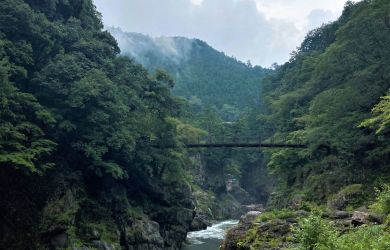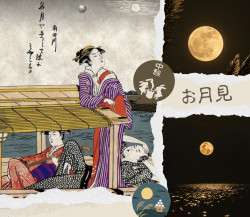
November 26, 2009
Best Japanese Songs
Metropolis asked 16 local writers and musicians to describe a formative encounter with a Japanese song. The resulting mix—from folk to noise to metal and enka—represents a half-century of sounds from one of the most diverse music scenes on the planet
Originally published on metropolis.co.jp on November 2009
Artist: Sayuri Ishikawa
SINGLE

Sayuri Ishikawa
When local kids deride enka, I try to nudge them in the direction of singer Sayuri Ishikawa’s classic 1977 outing. Literally translated as “Winter View of Tsugaru Straits,” this song represents the ’70s and Japan at their best. Mournful and kitsch, grandiose yet poignant, the music here sublimely infuses a funky orchestral backdrop with graceful power vocals that drift toward Gloria Gaynor. The song was conjured up by lyricist Yu Aku with composer Takashi Miki (a.k.a. Tadashi Watanabe), who passed away earlier this year and who was also responsible for the insanely catchy “Anpanman no March” theme song. This is the first and only enka number I’ve actually fallen in love with—there’s fuyu (winter), my favorite season (I have a silly tattoo of the kanji to prove it), and as a hack DJ I’ve dropped this song between techno and hip-hop tunes in clubs as far afield as Beijing and Melbourne… and it’s (somehow) worked. It’s also the one song I coerce my Japanese mates to sing at karaoke—they’re never quite Ishikawa, of course, and they grimace a bit, but they always give it their best.
Journalist Andrez Bergen is a Japanese music groupie, from noise and taiko through its more dulcet J-pop moments
[trailer]el_xWe25iHo[/trailer]
Artist: Kan Mikami
Album: Mikami Kan no Sekai
“Pistol Ma No Shonen” (“Boy With A Gun”) sums up Kan Mikami’s lyrical mode as well as any song in his 40-year career. In this 1971 outing, the beatnik enka-blues howler, backed only by an acoustic guitar, fires off a two-minute surrealist chronicle in which he identifies with Japan’s ultimate outsider of the time, Aomori country boy-turned teen serial killer-turned death-row poet, Norio Nagayama. Mikami has said he knew the song would be banned, but he refused to censor himself and released it anyway, as if turning away in disgust at Japan’s ’70s folk boom, which had previously seemed set to usher him to stardom. Today, those folkies are barely footnotes; Mikami’s career flourishes.
David Hickey has written on Japanese music for The Wire, Time Out and
Allmusic.com
Artist: Chiemi Eri
SINGLE: “Tennessee waltz” (B-side)
This cover of Rosemary Clooney’s classic was the first song that I knew came from Japan. Originally, the brassy big band number was about hospitality: the singer (female) inviting the listener (ostensibly male) in for a snack, listing all the foods on offer. A few cover versions later and the welcome had become, shall we say, warmer. By 1952, when Eri belted it out, the song was a complete come-on, her delivery just as sassy and seductive as Clooney’s—and perhaps more so as she straddled the language divide. As a self-important art student 20 years ago, I thumbed my nose at the pop music of the day, but friends had recently turned me on to the splendor of Frank Sinatra, Sarah Vaughn and other standard-bearers who sounded fantastic when bellowed in the wine-soaked wee hours of the morning. “Come on-a My House” made me realize that pop, and by extension J-pop, was too large a genre to dismiss outright, and that not all Showa-era women were as demure as I thought.
Jason Jenkins is a freelance writer/producer covering Tokyo’s music and contemporary art scene since 2001
[trailer]0ambg_SvuOY[/trailer]
Artist: Jacks
Album: Jacks no Sekai
Like many of rock’s great innovators, Jacks didn’t get the recognition they deserved until long after the fact. Led by the mercurial Yoshio Hayakawa, the band recorded a pair of albums in the late ’60s that were everything pop music at the time wasn’t: tense, ugly, and—lyrically, at least—a total downer. It’s hard to pick a favorite, but the opening track on their 1968 debut Jacks no Sekai is a definite contender. This ode to the allure of stormy nights (yeah, I know…) starts with 30 seconds of drum clatter before Hayakawa’s vocal enters, first morose but later erupting into an ungodly shriek that still gets me every time. The group’s performance is loose and frayed in the way that only a band still figuring out how to play their instruments can be. Jacks would call it quits a year later, but their legacy has endured: if you’re searching for the ground zero of Japan’s psychedelic rock explosion, you’ve just found it.
James Hadfield is the editor of Metropolis and a founding member of improvising orchestra Shit
Artist: Momoe Yamaguchi
Album: Manjushaka

The definitive idol-turned-icon, Momoe Yamaguchi exudes a magic that has eluded all idols who have come in her wake. Her career trajectory best compares to that of The Beatles: in seven years, she went from fresh-faced starlet to innovative trendsetter, all the while earning both critical and commercial success. And then she was gone. “Yokosuka Sunset-Sunrise” exemplifies a golden touch that enchants to this day. The first few seconds’ hypnotizing aura is defined by cosmic keyboards, a gritty, propulsive rhythm, and spine-tingling orchestration. Yamaguchi’s overdubbed vocals and casual sighs illuminate her command of the most affecting and melancholic lyrics: a couple in the arms of youth discover first love atop a hillside, gazing at the sunset, the salty sea breeze caressing them until sunrise. The girl receives her first kiss on her brow. Years later, she returns to the same spot, only to realize that the moment left a scar deep in her heart, one kept fresh by the image of the sun’s rise and fall. Performed live at Yamaguchi’s 1980 farewell concert, the song has a double meaning that’s emblematic of the nation’s love affair with the singer. Fittingly, the 21-year-old never appeared in public again.
Robert Michael Poole is director of SomethingDrastic Artist Management
[trailer]gcF6lPIhIkI[/trailer]
Artist: Judy and Mary
Album: Pop Life

Judy and Mary
It might be Hakodate’s apartness—a jump across the Tsugaru Strait from Honshu—that informed the infectious apartness of Judy and Mary’s sound. For this listener, “Music Fighter” captures the band at their eclectic best. Yuki Isoya’s faux-scat bounces over a jazzy guitar intro before the diminutive vocalist’s shrill “Yeah!” launches the tune into cacophony. Takuya Asanuma’s phase-shifted guitar takes the verses to flight, where Isoya bends and howls toward the tumultuous chorus, climaxing with the irresistible “I’m music fighter… OK! OK! OK!” The lyrics may recall Lautreamont’s frenetic surrealism, but it’s the raw musical energy that propels “Music Fighter.” The innovatively structured and dynamically produced single hit the charts in the spring of 1998, when Judy and Mary were already one of the hottest acts in Japan. Amazingly, it could be heard anywhere from grungy Koenji nightclubs to pristine Ginza department stores. I had it on my Walkman, and when the four minutes were up, would usually stab at the “repeat” button to take the ride again.
Monty DiPietro has written on art and culture for the Japan Times, International Herald Tribune and ARTnews
[trailer]26975zU8OwE[/trailer]
Artist: Sigh
Album: Hail Horror Hail
When I think about Japanese music—or any kind of art and media produced in Japan—the first word that comes to mind is “weird.” One of the best examples of that would be the black metal band Sigh. “Hail Horror Hail,” from the 1997 album of the same name, marks the beginning of the group’s foray into strangeness. With guitar riffs that sound more akin to a ’70s hard rock band backing Sigh’s more recognizably black metal raspy and shrieking vocals, things are fairly odd from the get-go. Halfway through—when the ragtime piano followed by a keyboard interlude that sounds lifted straight from a ’20s silent horror flick suddenly cuts in—is when things start to get really strange. While every kind of music has now been mixed with metal by one band or another, experimentation was frowned upon much more in the underground scenes back then. Sigh’s songwriting not only helped start a trend, but also put Japan on the map as a place to find quality metal. “Hail Horror Hail” might not be the group’s strangest moment, and their sound only improved on later albums, but the song set the tone of what was to come—a really bizarre tone.
Kevin Gillich is a freelance writer who came to Japan to see if bands like Sigh and Boris were just a fluke or if there was something really awesome going on here
[trailer]NfRGvrfdpds[/trailer]
Artist: Hanatarash
Album: 4

A testament to all that is punk, monstrous and perplexing with the Kansai scene, this 1996 song captures unholy junk brethren Hanatarash at their most audacious. While the Funkadelic grand hymnal “Good Thoughts, Bad Thoughts” lumbers away on half-speed in the background, (a pre-Yamataka) Yamatsuka Eye conducts choirs of cartoon hellhounds, performs baby exorcisms, and interrupts the black gospel like a blubbering demon demanding Eddie Hazel’s soul for dinner. Of course, this might not be the finest cut of the album (which goes perhaps to the gargling scratchfest of “Here Come the Hanatara-Crew”) or even the best named (“Vegetalian is Meat” and “Rat Pows Penguin” are contenders), but this song is unrivaled for its sheer Nipponese chutzpah. Eye & Co. ostensibly knew the extent of their trespass and veritably took it to a place beyond musical reckoning, perhaps reflecting Eye’s collage work more than his musical pursuits with the Boredoms at the time. From the band that drove a backhoe bulldozer through the wall of Tokyo’s Superloft in 1985, “How to Use My Hole” is pure living art by one of Japan’s great creative geniuses.
Cal Lyall is a musician, collector and victim to arcane sounds for over 30 years
Artist: Frank Chickens
Album: We Are Frank Chickens
Not necessarily the best Japanese song, “We Are Ninja (Not Geisha)” is, possibly, the most important to me. I believe I first heard it when my Dad picked up the 12” for me in London when I was a kid. Up to that point (1984), I don’t think I had really heard any Japanese music, though anything with “Ninja” in the title would have piqued my interest. The production was very advanced for the ’80s, and “We Are Ninja (Not Geisha)” was probably the first song I really got into where I had no idea what they were saying. (Of course, I really had no idea what Duran Duran were singing about, but at least I could sing along to more than the chorus.) I kind of forgot about the track until years later when my friend, DJ Duck Rock, played it at a party we were doing in Shimbashi. It instantly took me back to the days of delivering newspapers, playing video games at the local Mini-Mart, and dancing to this in the basement.
Sebastian Mair has been a music industry consultant in Japan for over 10 years and is also a cultural officer (music) at the Canadian Embassy
[trailer]cXZanbZ6PWs[/trailer]
Artist: Soul Flower Union
Album: Electro Asyl-Bop
“Mangetsu no Yube” is an achingly beautiful ballad that should eventually be acknowledged as a classic in the same league as “Ue o Muite Aruko” (aka “Sukiyaki”). The song was co-written by Takashi Nakagawa of ethno-rock group Soul Flower Union and Hiroshi Yamaguchi of the duo Heat Wave (both of whom have recorded their own versions of the tune) to cheer up the victims of the 1995 Kobe earthquake. But “Mangetsu no Yube” has never really received the recognition that it deserves, which is a shame. In contrast to the clichéd, anodyne nature of far too much J-pop, “Mangetsu no Yube” (“Full-Moon Evening”) is one straight from the heart, with a lush melody that perfectly complements the melancholic, romantic tone of the lyrics. And if you don’t find yourself singing along with the stirring “Yasahouya” chorus, you probably need a new blood supply. Steve McClure is executive editor of online newsletter
McClure’s Asia Music News www.mccluremusic.com and the author of Nippon Pop, the first English-language book on Japanese pop music
Artist: GO!GO!7188
Album: Tategami

Of course, it’s impossible to choose one favorite song across all the amazing bands and twisted genres Japan has to offer, and Metropolis music editor Dan Grunebaum is clearly a wicked sadist to put us through an ordeal as horrific as trying to do so. Still, “Ukifune” is a track I fell in love with on my first visit to Japan. Combining a rich Eastern melody with reverb-soaked guitar, powerful distorted bass and a sharp snare sound, it drips malevolent mystery. The arrangement is stunning—after the first rock-out chorus, it drops to a ponderous guitar line, then a bass response, then erupts into a rockabilly middle-eight before crashing back into a gut-wrenching coda. The verse is never repeated, which is probably what makes the song so moreish. Although released in 2003, “Ukifune” has a primeval Japanese flavor. It’s based on the story of the tragic princess of the same name from the ancient Tale Of Genji, and as such it carries a mournful sense of solitude, longing and bitterness, with a vocal performance by Yuu Nakashima that is guaranteed to give you goose bumps.
Daniel Robson is a music writer and event organizer; he also hosts the monthly It Came From Japan podcast
[trailer]f5C-C9Ym8P8[/trailer]
Artist: Typhoon Natali
Album: Cat & Spider

A best Japanese song? Some would say that’s like choosing your cuddliest Nazi. Of course, there are more good Japanese songs than good Nazis (just), and some (listed here) are very, very good. I’ll discount jet-fingered guitarist Atsushi Yokozeki (no vocals), Orange Kandy (awesome songs, poorly produced), “Mountain Top” by hard rockers Vow Wow (produced and recorded in the US), all-girl bands Show-Ya (“Genkai Lovers”) and Jaco-Neco (“Sexy Monkey”) ’cos I don’t want to be sexist, stunning dance classic “This Is Pop” by Yoko Oginome (I was the agent for the song), and even my favorite ever Japanese pop song, “Ki ga Tooku Naru Made Taki Shimete” by my fave Japanese band, Passengers (singer Miki Ohno hated it). Runner-up is Masahiro Motoki’s “Hatchi no Musashi Wa Shinda-no Sa” (what a synth riff, and the production job makes even Mok-kun sound like a musician), but the Japanese song that just smacks you from your face to your feet is “Buriki no Yume” by Typhoon Natali. From the dirty, dirty opening riff to the dirty, dirty mania of vocal vixen Lisa and the grinding rhythm of megabass legend Shige Kawakami, this 1990 song just grabs you by the balls and bounces you off the walls. If your foot doesn’t tap to this, you’re dead a thousand times over.
Fred Varcoe is a journalist with short hair who still thinks he has long hair
[trailer]2WoQW8kvrNE[/trailer]
Artist: Pizzicato Five
SINGLE

Sung by effervescent warbler Maki Nomiya, Pizzicato Five’s bouncing 1993 track celebrates the beckoning promise of a Tokyo night. (“The Night is Still Young” was the English title, although “It’s Seven O’Clock in Tokyo” is a more accurate translation.) Or does it? On closer examination, bandleader Yasuharu Konishi’s lyrics depict a woman stood up by her date, who then cries herself to bed in a hotel room, only to find a cryptic message from him on her answering machine. Or is it all a dream? Capturing the ambiguity of a mid-’90s Tokyo still flush with cash but beginning to sense that the party was over, “Tokyo wa Yoru no Shichi-ji” became a standout track of the Shibuya-kei scene, which saw über-hip cultural plunderers like P5 and Cornelius mining anything from ’60s pop to film soundtracks with ironic intent. The song also marked a high point in the fortunes of Japanese pop, graphic design and fashion, and continues to be covered and remixed on dancefloors worldwide.
Dan Grunebaum is the Music & Performing Arts editor for Metropolis
[trailer]JymRTfZCZoI[/trailer]
Artist: Electric Eel Shock
SINGLE

Photo by Dan Grunebaum
With its rigorously drilled “idol” groups, “cute” tone-deaf singers, rampant cross-media marketing, and questionable music charts, the Japanese music scene can sometimes seem a particularly loveless and Orwellian place. Anyone aiming for the freedom and joie de vivre normally associated with rock ‘n’ roll would be well advised to follow the trail blazed by Electric Eel Shock. In tune with the real spirit of rock, the three-piece from Osaka spend more of their time touring grungy venues in Europe and America in a beat-up jalopy than hanging around the offices of Tokyo management companies, practicing their bows and keigo for an appearance on Music Station. This is reflected in their road-tested version of old school ’80s hard rock, which comes with wit, intelligible English lyrics, and a real sense of the lads enjoying themselves. “Rock & Roll Can Rescue the World” from 1999 extends the personal epiphany they have found through garage metal into a message of global hope via some fantastic riffing, searing Eddie Van Halen-style breaks, and a strategically placed burp.
C.B. Liddell is the Art editor for Metropolis
[trailer]E7eQjLrgmdI[/trailer]
Artist: P-Model
SINGLE

Opening with a distinctive pico-pico rhythm machine intro, P-Model’s 1979 single “Bijutsukan de Atta Hito Daro” is one of the all-time classics of Japanese new wave and a landmark in the emergence of techno-pop. While its punk-era influences (particularly XTC and Devo) must have been a shock to audiences at the time, it was nonetheless a hugely influential track, opening the way for bands like The Plastics and precipitating a sea change in music that dragged Japanese pop out of the swooping, romantic era of ’70s kayokyoku and into the shiny, plastic future of J-pop. At first glance, the lyrics are about meeting a girl at an art gallery, but as the song progresses and the pop-art images build, it’s as if the romance has itself become another exhibit, with explosive, kinetic images of the burning gallery and smashing glass kept in check by the insistent, metronomic beat and barely restrained passion and desperation of Hirasawa Susumu’s breathless vocal delivery. P-Model’s own English title for the song, “Artmania,” seems to suggest that the art itself is what gets them fired up, rather than the girl.
Ian Martin is a Tokyo-based music writer, event organizer and owner of Call And Response Records
[trailer]W4xKfaFh5DY[/trailer]
Artist: Hibari Misora
Album: Kawa no Nagare no Yoni ~ Fushicho Part II

In April 1988, legendary enka singer Hibari Misora made a comeback from lung and bone disease to sing “Kawa no Nagare no Yoni” at the newly opened Tokyo Dome. The song, released the following year just a few days after Emperor Showa’s death, became her last. Roughly translated, it’s a resolution to accept life’s ups and downs like the “flow of the river.” Hibari was an old-fashioned singer complete with the gangster ties, the heavy drinking, and the tragic popularity. Her career rose right along with postwar Japan, and her death symbolized the end of the Showa era—indeed, Misora is sacrosanct to many, not only for her voice, but because she goes beyond music to symbolize a generation. In the Japanese music industry today, it’s hard to wade through all the idol groups, the awkward English lyrics, the outdated pop clichés, and find a popular Japanese song that actually symbolizes the country. I may not be the biggest fan of Showa-era Japan, but as a musician, Misora gets my ballot for symbolizing all that the country went through.
Isaku Kageyama is a member of taiko group Amanojaku
[trailer]UidYz1Je77s[/trailer]







